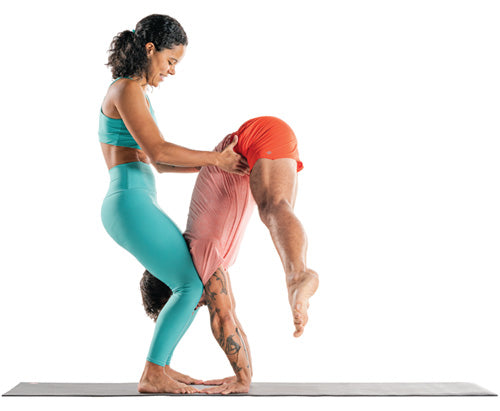Drills for Improving Handstands
This is an excerpt from Rocket® Yoga by David Kyle.
Walking on Hands
It’s important to feel comfortable upside down and be willing to catch yourself with your hands if you lose your balance. This is also an exercise that is fun to learn. You do not have to be perfect at handstand walking to take advantage of the skills it will teach you.

Cartwheels
This is another fun practice that will help with controlled exits from your handstands. Practice cartwheeling on both the right and left sides, slowing the cartwheel to extend the time you spend on your hands. Play with bringing the legs together midcartwheel before stepping out.

Walking Sideways on a Wall
This can be challenging at first. Do a supported handstand with the wall behind you. Shift your weight to the right hand, and step your left hand toward your right hand. Then, shift your weight to your left hand and walk your right hand out to the right. Keep shifting your weight from hand to hand, stepping each hand out as you move to the side. Once you can take a few steps to the right and left, you will gain more control over maintaining a center and not falling to the side.

Pike or Tuck
Learn how to access the anterior and posterior tilt of the pelvis while in a handstand. These actions can be small or exaggerated. Any type of exaggeration is considered an advanced technique. Subtle control of this area will produce a stronger balance on the ground. Training both the pike and the tuck techniques will help you to find your balance from the core of the body instead of using your legs to balance you.
You can practice using a wall for support or in the center of the room. While in a handstand, bring the legs to the pike position, moving your legs slightly forward to the front of the body. Simultaneously, allow the sacrum and pelvis to extend to the back of the body as a counterbalance. This is not a straight line. Instead, you will have a slight curve in the lower-lumbar area and softness in the glutes. Keep the shoulders stacked and avoid arching the upper back. Bring the legs back up to a full handstand.
For a tuck, start in a handstand and tighten the glutes and tuck the tailbone with a small push of the pubic bone forward. Let the head drop between the shoulders and shift your gaze behind you.
Explore holding the handstand for longer periods of time (even with a teacher’s support) so you can work both the tuck and pike actions together. Your goal is to find the balance between the two actions where you feel most comfortable.

Straddle Press
This exercise is best done with a partner but can also be done with a wall for support. This will train the muscles needed to support the eventual handstand that you will master on your own. If you’re using a wall, come to a full handstand, then rest your hips on the wall. Slowly straddle your legs out to each side, moving with control, and lowering them as far as you can while maintaining control. Bring the legs back up to a full handstand. To do this with a partner, they stand in front of you and hold your hips and support your shoulders as you straddle press up to a handstand.

SHOP

Get the latest insights with regular newsletters, plus periodic product information and special insider offers.
JOIN NOW


